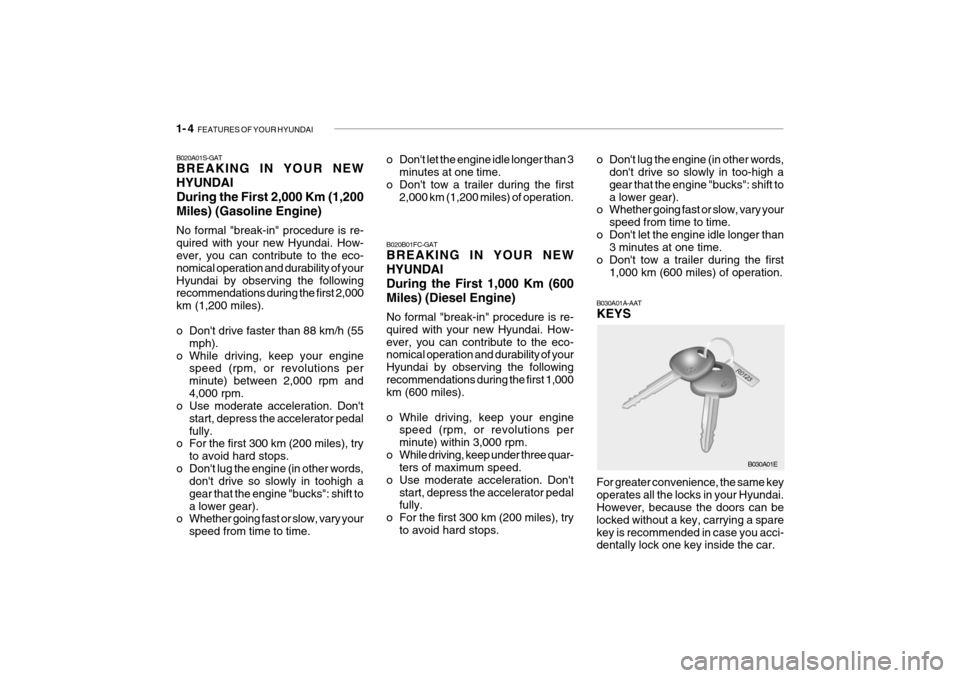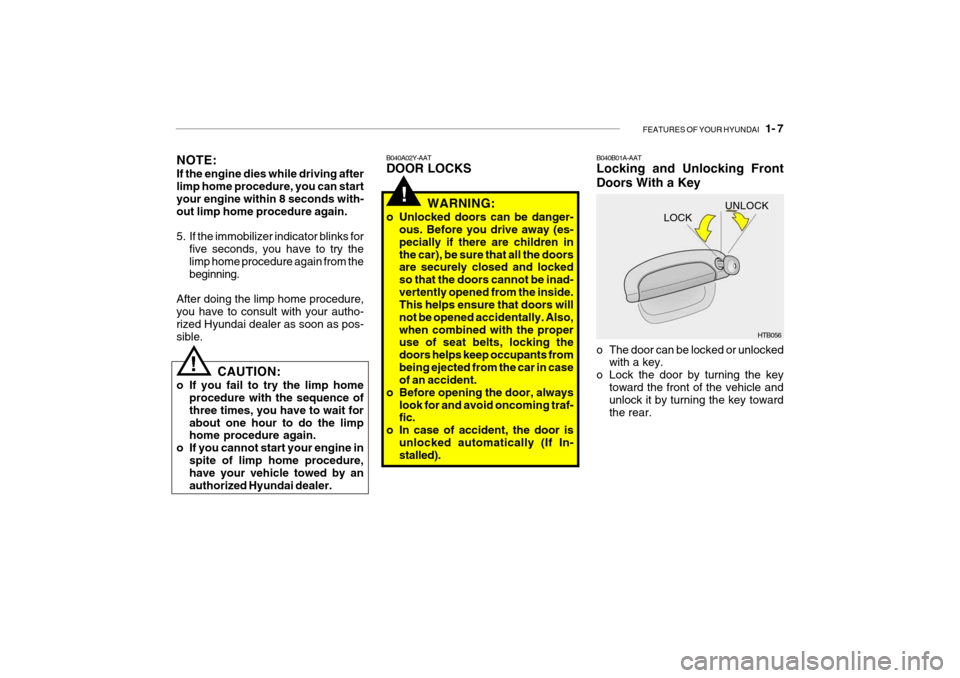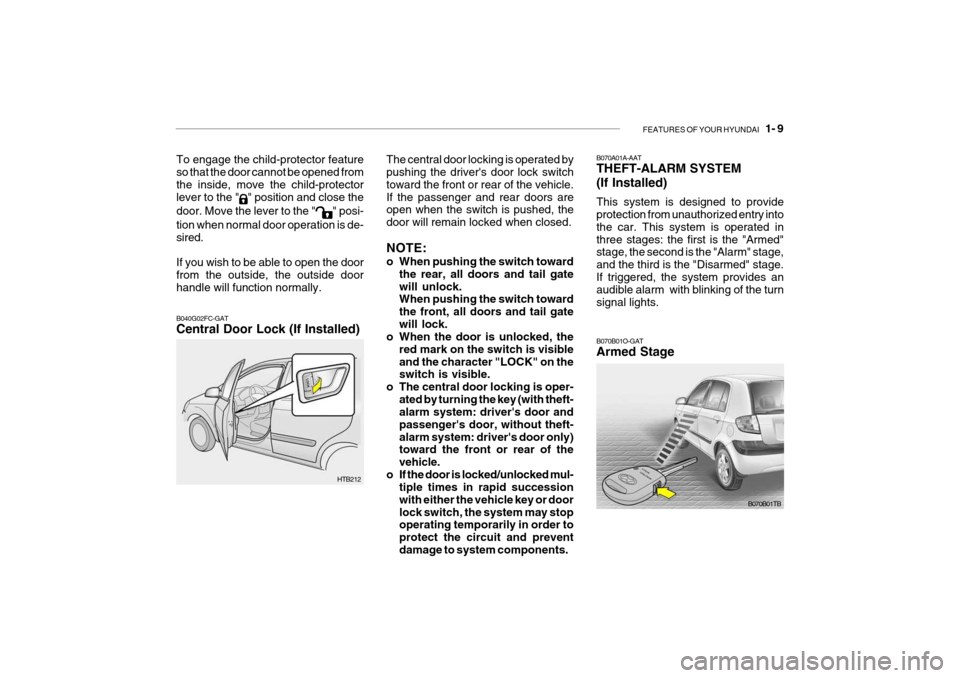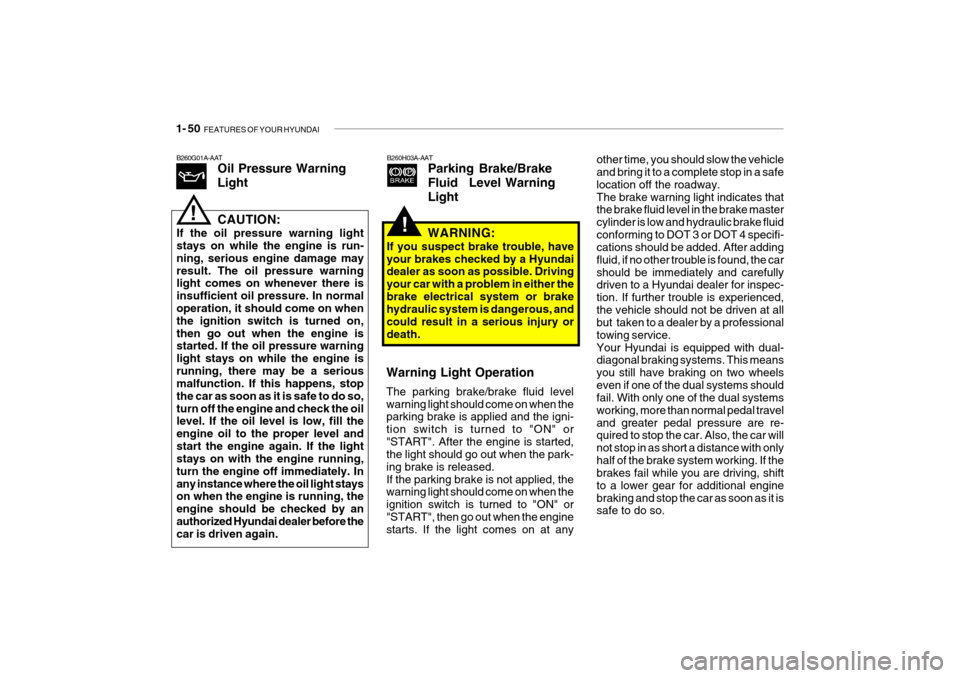tow Hyundai Getz 2008 Owner's Manual
[x] Cancel search | Manufacturer: HYUNDAI, Model Year: 2008, Model line: Getz, Model: Hyundai Getz 2008Pages: 383, PDF Size: 9.23 MB
Page 16 of 383

1- 4 FEATURES OF YOUR HYUNDAI
B020B01FC-GAT BREAKING IN YOUR NEW HYUNDAI During the First 1,000 Km (600 Miles) (Diesel Engine) No formal "break-in" procedure is re- quired with your new Hyundai. How-ever, you can contribute to the eco- nomical operation and durability of your Hyundai by observing the followingrecommendations during the first 1,000 km (600 miles).
o While driving, keep your engine
speed (rpm, or revolutions per minute) within 3,000 rpm.
o While driving, keep under three quar- ters of maximum speed.
o Use moderate acceleration. Don't start, depress the accelerator pedal fully.
o For the first 300 km (200 miles), try to avoid hard stops. B030A01A-AAT KEYS For greater convenience, the same key operates all the locks in your Hyundai. However, because the doors can be locked without a key, carrying a sparekey is recommended in case you acci- dentally lock one key inside the car.
o Don't lug the engine (in other words,
don't drive so slowly in too-high a gear that the engine "bucks": shift toa lower gear).
o Whether going fast or slow, vary your
speed from time to time.
o Don't let the engine idle longer than 3 minutes at one time.
o Don't tow a trailer during the first 1,000 km (600 miles) of operation.
B030A01E
B020A01S-GAT BREAKING IN YOUR NEW HYUNDAIDuring the First 2,000 Km (1,200Miles) (Gasoline Engine) No formal "break-in" procedure is re- quired with your new Hyundai. How- ever, you can contribute to the eco- nomical operation and durability of yourHyundai by observing the following recommendations during the first 2,000 km (1,200 miles).
o Don't drive faster than 88 km/h (55
mph).
o While driving, keep your engine speed (rpm, or revolutions per minute) between 2,000 rpm and4,000 rpm.
o Use moderate acceleration. Don't
start, depress the accelerator pedalfully.
o For the first 300 km (200 miles), try
to avoid hard stops.
o Don't lug the engine (in other words, don't drive so slowly in toohigh agear that the engine "bucks": shift toa lower gear).
o Whether going fast or slow, vary your
speed from time to time. o Don't let the engine idle longer than 3
minutes at one time.
o Don't tow a trailer during the first 2,000 km (1,200 miles) of operation.
Page 19 of 383

FEATURES OF YOUR HYUNDAI 1- 7
NOTE: If the engine dies while driving after limp home procedure, you can start your engine within 8 seconds with-out limp home procedure again.
5. If the immobilizer indicator blinks for
five seconds, you have to try the limp home procedure again from the beginning.
After doing the limp home procedure,you have to consult with your autho-rized Hyundai dealer as soon as pos- sible.
! CAUTION:
o If you fail to try the limp home procedure with the sequence of three times, you have to wait forabout one hour to do the limp home procedure again.
o If you cannot start your engine in spite of limp home procedure,have your vehicle towed by an authorized Hyundai dealer.
UNLOCK
B040A02Y-AAT DOOR LOCKS
B040B01A-AATLocking and Unlocking Front Doors With a Key
HTB056
LOCK!WARNING:
o Unlocked doors can be danger- ous. Before you drive away (es- pecially if there are children inthe car), be sure that all the doors are securely closed and locked so that the doors cannot be inad-vertently opened from the inside. This helps ensure that doors will not be opened accidentally. Also,when combined with the proper use of seat belts, locking the doors helps keep occupants frombeing ejected from the car in case of an accident.
o Before opening the door, always look for and avoid oncoming traf-fic.
o In case of accident, the door is unlocked automatically (If In-stalled). o The door can be locked or unlocked
with a key.
o Lock the door by turning the key
toward the front of the vehicle andunlock it by turning the key toward the rear.
Page 21 of 383

FEATURES OF YOUR HYUNDAI 1- 9
To engage the child-protector feature so that the door cannot be opened from the inside, move the child-protectorlever to the "
" position and close the
door. Move the lever to the "
" posi-
tion when normal door operation is de- sired. If you wish to be able to open the door from the outside, the outside door handle will function normally.
HTB212
B040G02FC-GAT Central Door Lock (If Installed)
B070B01TB
The central door locking is operated by pushing the driver's door lock switch toward the front or rear of the vehicle.If the passenger and rear doors are open when the switch is pushed, the door will remain locked when closed. NOTE:
o When pushing the switch toward
the rear, all doors and tail gate will unlock. When pushing the switch toward the front, all doors and tail gatewill lock.
o When the door is unlocked, the
red mark on the switch is visibleand the character "LOCK" on the switch is visible.
o The central door locking is oper- ated by turning the key (with theft-alarm system: driver's door and passenger's door, without theft-alarm system: driver's door only) toward the front or rear of the vehicle.
o If the door is locked/unlocked mul- tiple times in rapid successionwith either the vehicle key or doorlock switch, the system may stop operating temporarily in order to protect the circuit and preventdamage to system components. B070A01A-AAT THEFT-ALARM SYSTEM (If Installed) This system is designed to provide protection from unauthorized entry into the car. This system is operated inthree stages: the first is the "Armed" stage, the second is the "Alarm" stage, and the third is the "Disarmed" stage.If triggered, the system provides an audible alarm with blinking of the turn signal lights. B070B01O-GAT Armed Stage
Page 26 of 383

1- 14 FEATURES OF YOUR HYUNDAI
WARNING:
To minimize risk of severe injury in the event of a collision or a suddenstop, both the driver and passen- ger seatbacks should always be in an upright position while the ve-hicle is in motion. The protection provided by the seat belts and airbags may be reduced significant-ly when the seatbacks are reclined. There is greater risk that the driver and passenger will slide under theseat belt which may result in seri- ous injury if a crash occurs when the seatbacks are reclined. The seatbelt cannot provide full protection to an occupant if the seat back is reclined.!WARNING:
To ensure the seat is locked se- curely, attempt to move the seat for- ward or rearward without using thelock release lever.!
To recline the seatback, lean forward to take your weight off it, then pull up onthe recliner control lever at the outside edge of the seat. Now lean back until the desired seatback angle is achieved.To lock the seatback into position, release the recliner control lever.
HTB026
B080C01A-AAT Adjusting Seatback Angle
HTB024
B080B02A-GAT FRONT SEATS Adjusting Seat Forward andRearward To move the seat toward the front or rear, pull the lock release lever up- ward. This will release the seat on its track so you can move it forward orrearward to the desired position. When you find the position you want, release the lever and slide the seat forward orrearward on its track until it locks into the desired position and cannot be moved further.
Page 28 of 383

1- 16 FEATURES OF YOUR HYUNDAI
HTB025
B080F01S-AAT Seat Cushion Height Adjustment (Driver's Seat Only) (If Installed) To raise or lower the front part of the seat cushion, turn the front knob for- ward or rearward. To raise or lower therear part of the seat cushion, turn the rear knob forward or rearward.
B080G01A-GAT Adjusting Armrest Angle (Driver's side only) (If installed)
The armrest will be raised or lowered manually. To raise the armrest, pull it up.To lower it, press the armrest down. HTB2049
HTB027
B080E01O-AAT Lumbar Support Control
(Driver's Seat Only) (If Installed) To adjust the lumbar support, turn the handle on the outboard or left side ofthe seat. To increase the amount of lumbar support, pull the lever forward. To decrease it, push the lever towardthe rear.
Page 29 of 383

FEATURES OF YOUR HYUNDAI 1- 17
B130A01A-AAT REAR SEAT ENTRY (For 3-door model) The front passenger seatback should be tilted to enter the rear seat. By pulling up on the recliner controllever (1) at the outside of the front passenger seat, the seatback will tilt forward and the seat will automaticallyslide forward. Rear seat occupants can tilt the front passenger seatback by depressing thefoot lever (2) as shown in the illustra- tion. HTB258
(1)
(2)
To recline the seatback, push the seatback folding lever toward the head- rest, and release it after the desired seatback angle is achieved.When you recline the seatback to de- sired position, always be sure it has locked into position.
CAUTION:
When reclining the seatback youshould adjust the seatback folding lever while standing.
!
WARNING:
Passengers sitting in the rear seat should be careful not to acciden- tally press the foot lever (2) whilethe vehicle is moving, as this may cause the seatback to move for- ward and injure a front seat occu-pant.!
B080I01TB
Seatback folding lever
B080I01FC-GAT REAR SEAT Adjusting Seatback Angle
Page 30 of 383

1- 18 FEATURES OF YOUR HYUNDAI
HTB2006Seatback folding lever
B090B01TB-GAT Folding Rear Seatback and Seat Cushion For greater convenience, the entire seatback and seat cushion may be folded down and up.
1. Push the headrest down to the low-
est position.
2. To fold down the seatback , push and hold the seatback folding lever toward the headrest, then push down the seatback.
HTB294
B099A02F-AAT BEFORE FOLDING THE REAR SEATS Outboard Rear Seat Belt
OTB038146
!
Rear Seat Center's 3 Point Type Seat Belt (If installed) In order to prevent the shoulder belt from being damaged while folding the rear seat, the shoulder belt must bepassed through the hanger to keep it out of the way.
CAUTION:
Seat belts must be removed from thehanger when in use.
Page 41 of 383

FEATURES OF YOUR HYUNDAI 1- 29
o Never allow a child to stand up or
kneel on the seat.
o Never use an infant carrier or child safety seat that "hooks" over a seatback; it may not provide ad- equate security in an accident.
o Never allow a child to be held in a person's arms while they are in a moving vehicle, as this could re-sult in serious injury to the child in the event of an accident or a sudden stop. Holding a child in amoving vehicle does not provide the child with any means of pro- tection during an accident, even if the person holding the child is wearing a seat belt.
o If the child restaint seat is not anchored properly, the risk of achild being seriously injured or killed in a collision greatly in- creases.
B230G01TB
To install a child restraint system in the outboard rear seats, extend the shoul- der/lap belt from its retractor. Installthe child restraint system, buckle the seat belt and allow the seat belt to take up any slack. Make sure that the lapportion of the belt is tight around the child restraint system and the shoulder portion of the belt is positioned so thatit cannot interfere with the child's head or neck. After installation of the child restraint system, try to move it in alldirections to be sure the child restraint system is securely installed. B230G01A-GAT Child Restraint System Installa- tion on Outboard Rear Seats
WARNING:
Do not install any child restraint sys- tem in the front passenger seat. Should an accident occur and causethe passenger side airbag to deploy, it could severely injure or kill an infant or child seated in an infant orchild seat. Therefore, only use a child restraint system in the rear seat of your vehicle.
If you need to tighten the belt, pull more webbing toward the retractor. When you unbuckle the seat belt and allow it toretract, the retractor will automatically revert back to its normal seated pas- senger emergency locking usage con-dition. NOTE:
o Before installing the child re-
straint system, read the instruc- tions supplied by the child re- straint system manufacturer.
o If the seat belt does not operate as described, have the systemchecked immediately by yourauthorized Hyundai dealer.!
Page 55 of 383

FEATURES OF YOUR HYUNDAI 1- 43
B240C01HP
WARNING:
o Extreme Hazard! Do not use a re- ward facing restraint on a seat protected by an airbag in front ofit!
o Modification to SRS components
or wiring, including the additionof any kind of badges to the pad covers or modifications to the body structure, can adversely affect SRSperformance and lead to possible injury.
!
o For cleaning the airbag pad cov-ers, use only a soft, dry cloth or one which has been moistenedwith plain water. Solvents or clean- ers could adversely affect the airbag covers and proper deploy-ment of the system.
o No objects should be placed over
or near the airbag modules on thesteering wheel, instrument panel, and the front passenger's panel above the glove box, because anysuch object could cause harm if the vehicle is in a crash severe enough to cause the airbags toinflate.
o If the airbags inflate, they must be
replaced by an authorized Hyundaidealer.
o Do not tamper with or disconnect
SRS wiring, or other componentsof the SRS system. Doing so could result in injury, due to accidental firing of the airbags or by render-ing the SRS inoperative.o Do not install a child restraint sys-tem in the front passenger seat position.
o A child restraint system must never be placed in the front seat.The infant or child could be se-verely injured by an airbag de- ployment in case of an accident.
o If components of the airbag sys-
tem must be discarded, or if thevehicle must be scrapped, certain safety precautions must be ob-served. Your Hyundai dealer knows these precautions and can give you the necessary informa-tion. Failure to follow these pre- cautions and procedures could increase the risk of personal in-jury.
o If you sell your vehicle, make cer-
tain that this manual is transferredto the new owner.
o If your car was flooded and has
soaked carpeting or water on floor-ing, you shouldn't try to start en- gine; have the car towed to autho- rized Hyundai dealer.
Page 62 of 383

1- 50 FEATURES OF YOUR HYUNDAI
other time, you should slow the vehicle and bring it to a complete stop in a safe location off the roadway.The brake warning light indicates that the brake fluid level in the brake master cylinder is low and hydraulic brake fluidconforming to DOT 3 or DOT 4 specifi- cations should be added. After adding fluid, if no other trouble is found, the carshould be immediately and carefully driven to a Hyundai dealer for inspec- tion. If further trouble is experienced,the vehicle should not be driven at all but taken to a dealer by a professional towing service.Your Hyundai is equipped with dual- diagonal braking systems. This means you still have braking on two wheelseven if one of the dual systems should fail. With only one of the dual systems working, more than normal pedal traveland greater pedal pressure are re- quired to stop the car. Also, the car will not stop in as short a distance with onlyhalf of the brake system working. If the brakes fail while you are driving, shift to a lower gear for additional enginebraking and stop the car as soon as it is safe to do so.
B260H03A-AAT
Parking Brake/Brake
Fluid Level WarningLight
Warning Light Operation The parking brake/brake fluid level warning light should come on when the parking brake is applied and the igni- tion switch is turned to "ON" or"START". After the engine is started, the light should go out when the park- ing brake is released.If the parking brake is not applied, the warning light should come on when the ignition switch is turned to "ON" or"START", then go out when the engine starts. If the light comes on at any WARNING:
If you suspect brake trouble, have your brakes checked by a Hyundai dealer as soon as possible. Driving your car with a problem in either thebrake electrical system or brake hydraulic system is dangerous, and could result in a serious injury ordeath.
!
B260G01A-AAT Oil Pressure Warning Light
!CAUTION:
If the oil pressure warning light stays on while the engine is run- ning, serious engine damage mayresult. The oil pressure warning light comes on whenever there is insufficient oil pressure. In normaloperation, it should come on when the ignition switch is turned on, then go out when the engine is started. If the oil pressure warning light stays on while the engine isrunning, there may be a serious malfunction. If this happens, stop the car as soon as it is safe to do so,turn off the engine and check the oil level. If the oil level is low, fill the engine oil to the proper level andstart the engine again. If the light stays on with the engine running, turn the engine off immediately. Inany instance where the oil light stays on when the engine is running, the engine should be checked by anauthorized Hyundai dealer before the car is driven again.